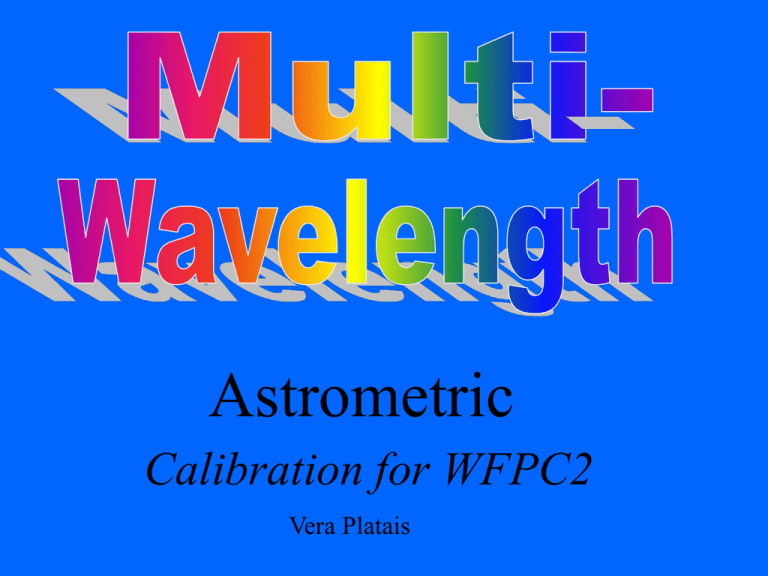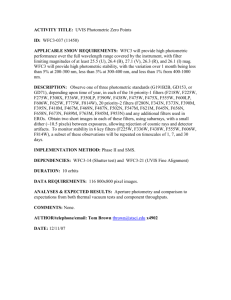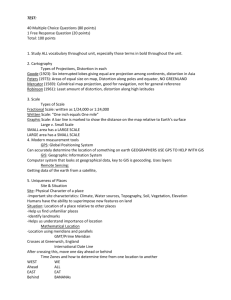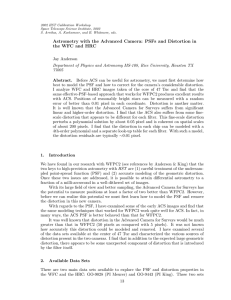Astrometric Calibration for WFPC2 Vera Platais
advertisement

Astrometric Calibration for WFPC2 Vera Platais WFPC2: 5 pix! (Holtzman et.al. 1995) Distorted coordinates Un-distorted coordinates Xg=a1+a2X+a3Y+a4X2+a5XY+a6Y2+a7X3+a8X2Y+a9XY2+a10Y3 Yg=b1+b2X+b3Y+b4X2+b5XY+b6Y2+b7X3+b8X2Y+b9XY2+b10Y3 Data Set: (CAL 6941 – 1997) - rich globular cluster ω Centauri. F555W F814W F300W Same pointing Same orientation Offsets: ±35 ", ±15 ", ±0.25" Data Set: (CAL 6941 – 1997) - rich globular cluster ω Centauri. F555W F814W F300W Same pointing Same orientation Offsets: ±35 ", ±15 ", ±0.25" First Solution – Analytical PSF fitting (IRAF/PSF) – standard error in positions F300W - 0.08; F555W - 0.05; F814W - 0.06 pix Metachip solution – (Holtzman-Casertano formalism): x,y of WF cameras transformed into global coordinate system with orientation and scale of PC1 x´=xcos -ysin + xoffset y´=xsin +ycos + yoffset X=x´scale Y=y´scale Measured positions in each filter, in the global coordinate system of PC1. Transformed coordinates X,Y were used for least square minimization of cubic distortion solution. A full set of coefficients aj,bj was derived. The Problem: Meta-chip distortion solution propagates distortion errors of one chip into the other chips. The residuals after correction show different amplitude and phase of distortion for each of WFPC2 cameras. The precision of meta-chip solution is about 0.3 pix Quo vadis? NOVUS VIA (A new approach) New approach: e_PSF (Anderson & King, 2000) measurement of stars positions with accuracy of 0.02 pix Astrometric flat-field (Anderson & King,2003) in F555W, improved the geometry distortion solution with accuracy 0.01 pix in WF and 0.02 pix in PC1. Anderson-King formalism includes four independent distortion corrections, one for each chip. A third order polynomial was used to represent the cubic distortion. Histogram – under-sampled stellar profile; Solid curve – Gaussian model; Dotted curve – combination of Gaussian and Lorentzian models Effective_PSF (Anderson & King 2000) e_PSF is entirely empirical; e_PSF is derived from observed pixel values; e_PSF is fitted to the pixel values by simple evaluation and scaling without any integration. The accuracy of e_PSF measurement of stars positions is 0.02 pixels for F555W, F814W and F300W filters. x,y x,y F555W x,y F814W F300W The residuals between the ‘astrometric flat field’ – F555W positions and star positions in F300W filter, applying only a linear transformation, for each chip independently. Astrometric flat-field (Anderson & King, 2003), the coordinates free of distortion (Xg, Yg) in F555W were used to derive geometric distortion corrections in X,Y positions for F814W and F300W filters. X=(x-425)/375 x,y XgYg x,y XgYg x,y Xg=a1+a2X+a3Y+a4X2+…+a10Y3 Yg=b1+b2X+b3Y+b4X2+…+b10Y3 XgYx,y g XgYg Y=(y-425)/375 10 set of aj bj for each chip & filter XgYg x,y aj ,bj for each chip & filter After applying the bicubicpolynomial, the residuals are essentially flat. The differences in the distortion correction are in the sense “F555W-F300W”. The average increase of distortion is ~3% in F300W and 1% in F814W. Residuals are scaled by a factor of 300. The max length for PC is 0.18pix The max length for WFs is 0.25 pix Conclusion The precision of the geometric distortion solution for the WFPC2 cameras depends on: centering technique in measuring positions of stars with under-sampled PSF; the independent chip-to-chip solution, rather than the meta-chip solution, excludes the error propagation from one chip to another; the amount of geometric distortion is a function of wavelength. Acknowledgements Gabriel Brammer for help with PowerPoint. Anton Koekemoer and Jay Anderson. Colin Cox and Richard Hook with IDCTAB . Imants Platais for helpful comments and suggestions at various stages of this project.









